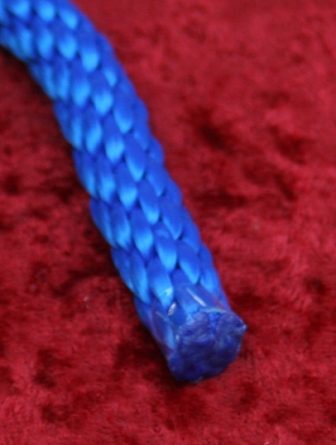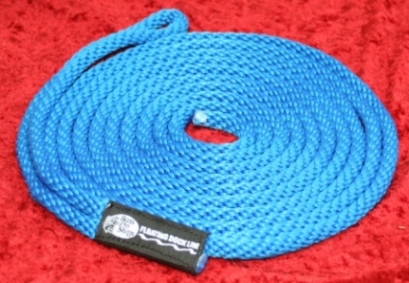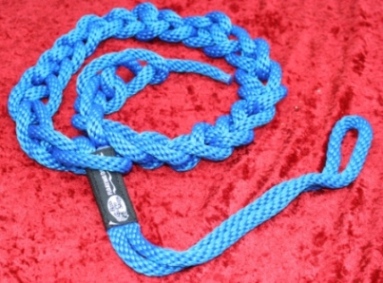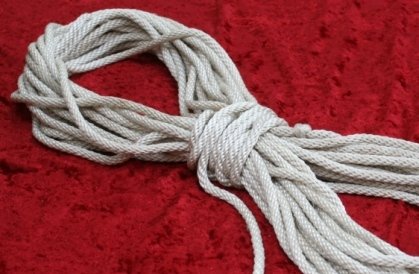Rope Storage & Handling
Learning the basics of rope storage and handling impacts you safety, makes it faster to tie up and reduces frustrations by reducing the likelihood your rope is twisted or in a knot.
- Cutting and Preventing Unraveling
- Storing Rope to Avoid Kinks and Unwanted Knots - Chain Sinnet , Gasket Coil
- Preventing Damage to Your Rope
- Protecting Self, Others and Property from Rope
- How to get your rope from here to there -Monkey Fist
Cutting and Preventing Unravelling
 Simple Whipping
Simple Whipping Sailor's Whipping is a simple concept of treating the end of your cut rope in a manner that wraps the end just below the cut with a tape, glue or whipping string similar to what you see on a fishing rod forming a knot of its own. This is perhaps the best looking. Most mooring ropes come with a form of whipping as you can see in the picture below of such a rope recently purchased at Bass Pro Shops. Scroll to the bottom of this page and view a U Tube video showing 3 methods using Whipping String to protect the end of your rope.
A simple Overhand Knot is often all that is needed before you cut your rope to prevent unravelling. Tie the knot then cut the rope. This works well but may may get in the way if you need to make some of the knots, hitches and bends mentioned on this website. Then you will need to learn the Whipping Technique or another one mentioned here. Click the link below and review the overhand know utility.
Melt The Ends: a common method many have used is to pass a flame from a match, torch or lighter on the rope end which melts the ends together securely. Care must be taken to not burn your fingers when you try as the melting rope stays hot for a time and can burn your skin. It is recommended to wear a leather glove to finish this technique.
As an Amazon Associate, we earn from qualifying purchases. Items we reference and recommend have been personally owned, used and tested or we have fished with anglers who were using them.
Cutting Your Rope
Cutting your rope can be done in a number of ways. The time to think about preventing your rope from unraveling is before you cut your rope. Small rope can be cut with scissors. Some people have used a utility razor knife. We have heard numerous stories about utility knives slipping and causing minor to major injuries. Always cut away from your hand or body if you choose this technique.
Rope Cutting Gun: the safest and most convenient way to cut rope is to use a rope cutting gun, which also melts the end which prevents unraveling. When you purchase synthetic rope from many hardware / home stores you will see they often use a rope cutting gun. This rope cutting gun cuts (actually melts) through the rope and leaves each end so that it won't unravel. This electric rope cutting gun cuts and seals the ends of synthetic ropes in one fast movement. Great for fusing polyester ropes, nylon ropes, and webbing.
Rope Storage
The simplest form of rope storage is a simple coil on the deck or floor called the Flemish Flake. This is best with a rather large rope which won't shift and will tend to stay in place and you have a rather large deck on your boat. Plus it looks great.
 Flemish Flake
Flemish Flake Another great storage solution for your rope is the The Chain Sinnet and has been passed down from generation to generation.
 Chain Sinnet
Chain SinnetAnother good option for rope storage is the Gasket Coil - pictured below.
 Gasket Coil
Gasket Coil Avoid Damaging Your Rope
What can damage Rope? Sharp objects, rough edges and corners. Any place a rope rubs over and over can impact your rope, so be sure to check all points over which your rope passes. Fishing hooks often get stuck in ropes - especially your anchor rope. If you can push the hook through the rope and compress the barb you can often pull the hook out without damage to the rope. Sadly the rope will need to be slightly cut in the hook removing process. So when it come to rope storage, it is best to avoid doing this by storing your rope away from fishing hooks. The next most common area of damage can occur from ropes that continually rub on the edge of your boat or dock when under load during storage. Called Chaffing, you can purchase products which can be applied to these sharp edges or to the rope to avoid this wear and tear.
Protection from Moving Rope
Remember when working with rope, especially when the rope is moving or under load that your hands, if not protected, can be injured. Wear gloves. Rope storage of your anchor rope is important to keep in mind who, when and where the rope will go when dropping your anchor. Your anchor rope leaves the boat at great speed can pull things into the water or trip someone who has it around their leg, Before throwing the anchor overboard, look around and clear a space to avoid making an error.
Getting Rope From Here to There
The Monkey Fist is a great knot to tie in the end of your rope that adds weight as an aide to toss it onto the dock or to a helper waiting to help tie off your boat. If for no other reason than it has one of the best names you ought to learn to tie this one. Click on the following link to learn how to tie the Monkey Fist.
